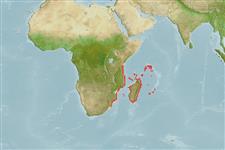>
Eupercaria/misc (Various families in series Eupercaria) >
Lutjanidae (Snappers) > Lutjaninae
Etymology: Lutjanus: Malay, ikan lutjan, name of a fish.
More on author: Cuvier.
Environment: milieu / climate zone / depth range / distribution range
Ecología
marino asociado a arrecife; rango de profundidad 10 - 50 m. Tropical; 4°S - 30°S, 30°E - 59°E (Ref. 55)
Western Indian Ocean: Mozambique, Natal in South Africa, Madagascar, Réunion and Mauritius.
Tamaño / Peso / Age
Maturity: Lm ? range ? - ? cm
Max length : 25.0 cm TL macho / no sexado; (Ref. 55); common length : 20.0 cm TL macho / no sexado; (Ref. 55)
Espinas dorsales (total): 11 - 12; Radios blandos dorsales (total): 12-13; Espinas anales 3; Radios blandos anales: 7 - 8. Dorsal profile of head steeply sloped. Preorbital width usually less than eye diameter. Preopercular notch and knob well developed. Scale rows on back rising obliquely above lateral line. Brownish dorsally, grading to yellowish-white ventrally, with a series of 6 narrow blue stripes. A blackish spot is usually present on the lateral line below the anterior portion of the soft dorsal fin rays.
Adults inhabit coral reefs where they occur usually solitarily or in small groups of about 5 to 10 individuals. They feed on fish and crustaceans (Ref. 5213).
Life cycle and mating behavior
Madurez | Reproducción | Puesta | Huevos | Fecundidad | Larva
Allen, G.R., 1985. FAO Species Catalogue. Vol. 6. Snappers of the world. An annotated and illustrated catalogue of lutjanid species known to date. FAO Fish. Synop. 125(6):208 p. Rome: FAO. (Ref. 55)
IUCN Red List Status (Ref. 130435)
Threat to humans
Harmless
Human uses
Pesquerías: comercial
Más información
Nombres comunesSinónimosMetabolismoDespredadoresEcotoxicologíaReproducciónMadurezPuestaAgregación para la puestaFecundidadHuevosEgg development
ReferenciasAcuiculturaPerfil de acuiculturaRazasGenéticaElectrophoresesheritabilidadEnfermedadesProcesamientoNutrientsMass conversion
Herramientas
Special reports
Download XML
Fuentes de Internet
Estimates based on models
Preferred temperature (Ref.
123201): 24 - 27.6, mean 26.2 °C (based on 44 cells).
Phylogenetic diversity index (Ref.
82804): PD
50 = 0.5000 [Uniqueness, from 0.5 = low to 2.0 = high].
Bayesian length-weight: a=0.01479 (0.00706 - 0.03101), b=2.97 (2.81 - 3.13), in cm total length, based on LWR estimates for this Genus-body shape (Ref.
93245).
Nivel trófico (Ref.
69278): 4.0 ±0.66 se; based on food items.
Resiliencia (Ref.
120179): Alto, población duplicada en un tiempo mínimo inferior a 15 meses (Preliminary K or Fecundity.).
Fishing Vulnerability (Ref.
59153): Low vulnerability (15 of 100).
Nutrients (Ref.
124155): Calcium = 57.7 [38.7, 84.0] mg/100g; Iron = 0.426 [0.263, 0.647] mg/100g; Protein = 18.5 [17.0, 19.9] %; Omega3 = 0.149 [0.103, 0.213] g/100g; Selenium = 54.3 [35.1, 82.4] μg/100g; VitaminA = 159 [29, 604] μg/100g; Zinc = 0.526 [0.409, 0.750] mg/100g (wet weight);
